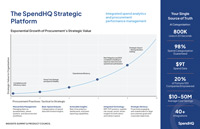How to Make Your Procurement Project Plan Strategic
What do you think of when you hear the words “procurement project?” For many teams, the term raises memories of being the last party brought into a contract negotiation or worse, processing a stack of purchase orders (POs).
For years, Procurement served businesses in a tactical and administrative role. However, changing enterprise needs gave the function a strategic focus. Now, it’s time for Procurement’s projects to evolve to the same level as the results they’re expected to produce. Here are six ways to build a procurement project plan that drives strategic results.
Differentiate between strategic and tactical initiatives
If you want to build a strategic Procurement project plan, you need to understand what a project will affect and how it will affect it. While no procurement projects are entirely strategic or tactical—they all have elements of both—each project will lean one way or the other. It’s entirely possible to set a ceiling on your strategic impact by focusing mostly on projects that produce tactical results.
So before you even take stock of potential projects, take some time to determine what defines strategic and tactical in your organization. Does the company need a better PO processing system? Finding a better way to intake purchases may look tactical, but it can create a strategic impact. On the other hand, pursuing process efficiencies while the company focuses on decarbonizing can lower your overall impact. By asking this question first, you can ensure that your project plan accomplishes what you wanted it to.
Take stock of what you can affect
Every company has two kinds of spend: the kind Procurement can affect and the kind Procurement can’t, no matter how hard they try. Creating a procurement project plan focused on purchasing factors that you can’t affect will put a dent in your impact.
Unfortunately, differentiating between impactable and non-impactable opportunities can be difficult because Procurement rarely has visibility into what’s happening across the organization. Thankfully, you can solve this problem. The first step is to obtain spend visibility so you can see all the organization’s spend in one place. This will show you the context around every area of spend you’re interested in addressing.
Then, establish communication chains with the business units in charge of these purchasing areas. When you have relationships with these stakeholders, figuring out what you can impact is as simple as asking. More importantly, though, building these relationships smooths the road ahead and reveals even more important opportunities. When business unit leaders see Procurement as an ally, they’ll be much more likely to show you the projects that really matter.
Understand whose help you need and involve them early
Likewise, you won’t get far with an initiative if your procurement project plan is missing the stakeholders who can help you put it into action. Without them, you’ll either lack the resources you need to do anything meaningful or you’ll accidentally make changes that disrupt their work. Neither is a good outcome.
However, you can make progress if you start by showing stakeholders your vision for the project. Use your spend analytics tool to show them the current realities of spend. Forecast the results of your project in a tool like Procurement Performance Management (PPM) to demonstrate how it benefits them. Most importantly, clearly state that you want to leverage your stakeholders’ abilities so the project becomes a joint effort. Doing so will give your project momentum and cement you as a strategic ally who stakeholders can come to on future initiatives.
Get ideas from stakeholders
Don’t stop at working with stakeholders; make sure they know you’re always open to their suggestions. Not only is this a great way to build alignment and collaboration, but it’s also a great way to find project ideas you would never know about otherwise.
By far the best way to show stakeholders that you want their ideas is to make them easy to share. Leverage a tool like PPM’s Opportunities module to create an idea drop box where stakeholders can submit project opportunities from anywhere, at any time. Then you’ll have no shortage of procurement project plan ideas to build on, and you won’t have to actively source them or come up with them yourself.
Filter opportunities through top-down strategy
Because procurement teams are at the heart of their businesses, their initiatives can have a significant impact on financial and non-financial development. To make your procurement project plans strategic, always align them with the board’s overall strategy.
Of course, this can be difficult because Procurement may not receive an invitation to high-level meetings. If you’re in this situation, start by running your ideas by the C-suite. They’ll quickly inform you whether or not your procurement project plan aligns with their wider goals. Then employ the other tips in this guide to execute efficiently and make sure the results are easy to see. Before long, you may find your team involved in setting strategy, not just aligning with it.
Manage your project the right way
The best plans in the world fall through unless they’re paired with high-level execution. If you really want to develop strategic procurement project plans, you need a way to turn them into action. Traditionally, this has been one of Procurement’s largest roadblocks because there wasn’t a great way to manage projects across business units. Many teams turned to spreadsheets only for duplicated documents, inaccurate information, and low visibility to throw their projects off track.
To drive uninterrupted, strategic impact, establish a single, transparent location where you and your stakeholders can track projects together. PPM’s Project Pipeline is the ultimate solution for doing just that. It creates a single source of truth where all relevant parties can go for updates on procurement projects, excepted results, and realized outcomes. With it, Procurement has a reliable tool for driving the action needed to push initiatives across the finish line and deliver on strategic impact instead of simply promising it.
Conclusion
Because Procurement touches almost everything companies do in one way or another, the function is in a unique position to drive business forward. Therefore, Procurement can make its impact strategic by connecting with stakeholders in a way that positions the function at the center of modern business.
The best way to do that is to see spend comprehensively and then arm yourself with performance management tools that make connecting with stakeholders easy. By combining engagement and alignment with the management tools in PPM, executing on strategic procurement plans becomes easier than ever before. To see it for yourself, click below to schedule a demo today.





